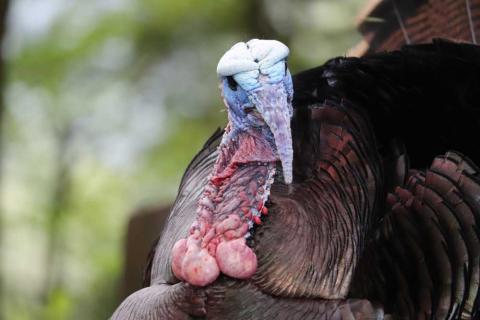Richard Hines | Originally published in GameKeepers: Farming for Wildlife Magazine. To subscribe, click here.
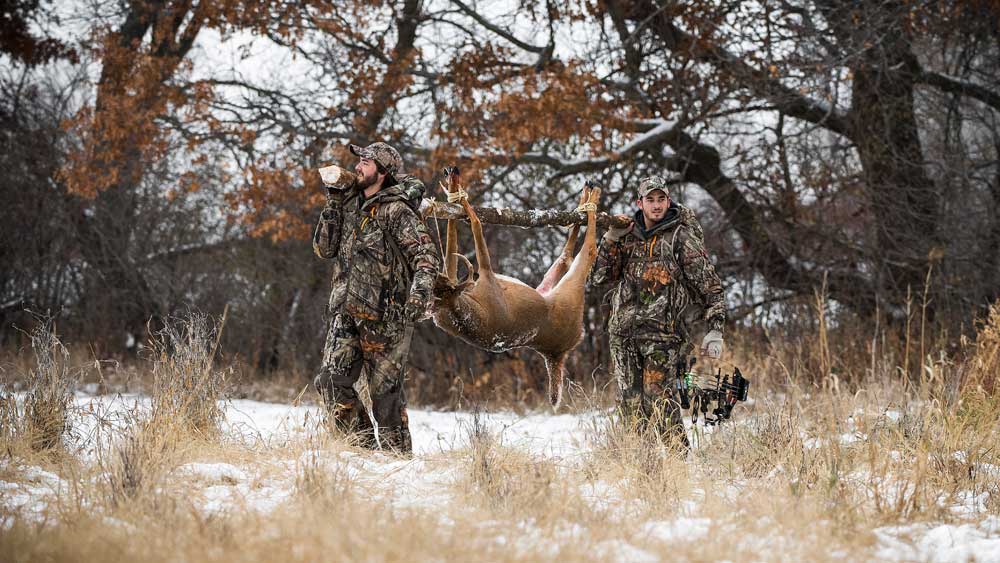
Anyone who has killed a deer knows the real work starts after the hunt, field dressing and skinning, de-boning, and prepping meat for the freezer. But now we have the remains to deal with? This is important, especially in today’s “CWD-tainted existence.” There are lots of options and having been a deer hunter for over 50 years I have seen carcasses disposed of in many ways and places. There are various options for carcass disposal and where and how you take care of this part of the hunt can either create problems or benefit the environment.
Last year I began thinking about some of the benefits and consequences after I had dropped a deboned carcass of a doe on our back field. It was about 200 yards from a box stand and I had intentions of sitting in the stand and hopefully shooting a coyote, but within a couple of hours the deer remains were being consumed by a pair of bald eagles. It was a pair that nested up the river from our house and I was happy to let them feast on the remains. Most raptors, including bald eagles, golden eagles and of course vultures will readily take carrion.
Once you dispose of your deer remains, it becomes “carrion,” which is Latin for dead-decaying flesh. It’s not as bad as you think, because carrion happens to be an important food source for many large carnivores and omnivores worldwide. Besides the usual suspects; vultures, hawks, crows, owls, eagles, fox, opossums, coyotes and the list goes on, also feed on carrion.
Another group you may not consider, are insects including burying beetles, carrion beetles, dung beetles, and the maggots of dozens of species of flies all of which help recycle nitrogen and carbon back into the local environment.
Every deer camp has a place to get rid of carcasses of cleaned deer, but times are changing. Even though your camp may already have methods of deer disposal planned, you and members of your hunting camp might want to reconsider some additional options before getting rid of your deer carcass. Believe it or not there has been a great deal of research on this subject of “what happens to carcasses” so here are some tidbits to think about, the good and the bad of getting rid of deer remains.
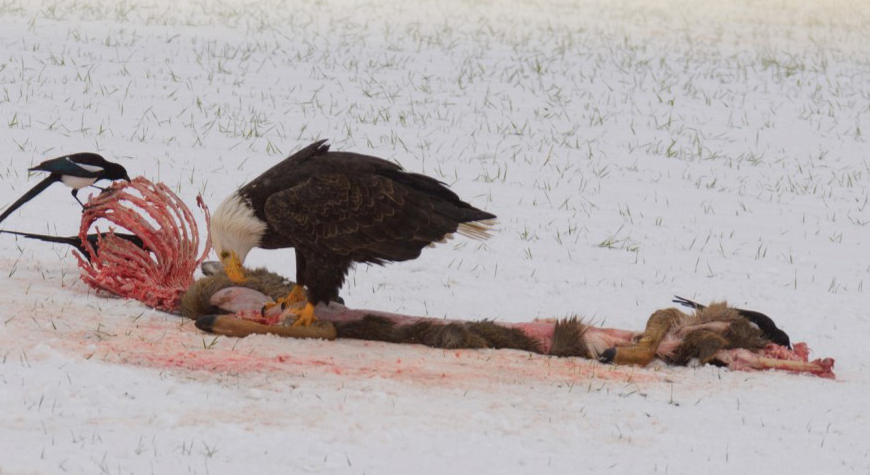
I use my 217-acre farm as an example. We gut and skin our deer at a shed and then later drop off the remains in the center of an open pasture. Those eagles I mentioned earlier are one of the reasons, but we also have a wide range of scavengers taking advantage of the free lunch. During the season, we generally dispose of eight to ten carcasses without any adverse effects.
What are your options? First and foremost, understand the laws in your state concerning the disposal of deer remains. Generally, leaving a gut pile and bones is acceptable on private lands, but I have seen some strange regulations on some public lands across the country, but generally deer gut piles left in the woods are overlooked, as it is a natural process. Evaluating your disposal site may require considering some of impacts, but using some past research may help in choosing a site.
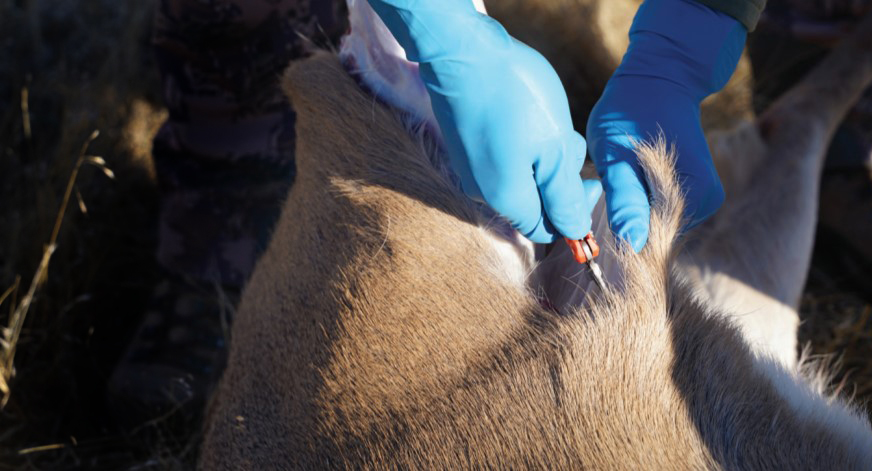
Streams as Disposal?
Placing a deer carcass in a stream was once commonplace, “let the crawfish eat ‘em.” But when throwing a carcass into a stream you may create problems for the stream, so this is not the way to go. Yes, the remains will eventually wash away, but the smaller the stream the greater the impact from carcasses.
Ward Wilson, Executive Director of the Kentucky Waterways Alliance said, “dumping remains of your skinned deer into a small stream can impact the stream because you are adding a large amount of organic material to the stream…and in many cases, it is more organic material than the stream can handle at one time.” True, the carcass ultimately breaks down, but decomposition consumes oxygen that is pulled from the water. Small aquatic insects beneficial to fish are also directly tied to the water’s oxygen content and when a carcass begins breaking down, bacteria will multiply and, in the process, consume much of the oxygen from the water in the immediate vicinity of the carcass.
If you are using the same disposal site, time after time, impacts to the stream are significant, potentially reducing aquatic life. The same is true of sinkholes which in many cases are tied to underground water sources. Carcasses can create an overload of bacteria into the local water table. Above all, avoid dropping deer carcasses into any watercourse!
Soil and Plants
When an animal dies in the woods or on the prairie, its decomposition is gradual, starting with raptors, small mammals, and insects each taking a share. As the carcass is no longer usable by larger birds and mammals, insects such as carrion beetles and dung beetles which are classified as “decomposers” take over the cleanup. During the process, there are also dozens of species of flies that are also consuming the carrion.
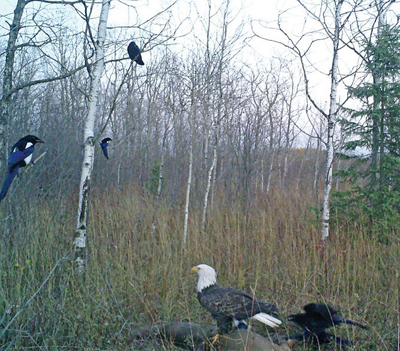
pile. This road-killed doe had these birds on it within an
hour after placing the carcass. That night the carcass was
moved about 20 yards by wolves and was basically gone
accept for the stomach, intestines and a few bones.
Leaving a carcass on grass will kill the vegetation for a short period of time, but one researcher, EG Towne found that large carcasses “creates an intense localized disturbance that varies with size of the carcass.” During the coming year, there is a large pulse of nutrients into the soil and over time Towne found that prairie plant complexity within the circle of the carcass increased plant diversity.
Terrestrial Disposal
On more than one occasion I have seen deer investigating gut piles from a deer that was skinned earlier in the day. My oldest son shot his first buck sniffing a gut pile of a deer that had been shot and gutted earlier that day on a public land hunt. Leaving the gut pile in the woods is by no means detrimental. We now hang and field dress deer in our shed, drop the entrails into a tub and place these in a wide-open field primarily for the benefit of our local eagles.
Researchers in Wisconsin were experimenting on numbers and species of animals that visited either dead deer or gut piles. Using trail cameras, they placed 40 deer and 10 gut piles on sites over an eight-month period and determined that 14 species of scavenging mammals, and 14 species of scavenging birds visited the sites.
Crows, raccoons, opossums, red-tailed hawks were among the visitors to the carcass sites. Deer were also regular visitors to carcasses, so if you have ever seen this, it is not an anomaly. During the study, carcasses utilization persisted for 18 to 101 days depending on the season. Obviously, carcasses disappeared fastest during warmer weather.
Coyotes
One question gamekeepers may have on dropping a deer carcass on their property. Will I increase coyotes? Food resources obviously will change, or determine coyote behavior. Coyotes, as will most carnivores, will eat carrion. Although not much when it comes to deer, one project looked at how dumping cattle carcasses on a large Texas ranch increased coyote numbers. When up to three dead cattle were placed near existing “carcass areas,” resident coyotes only visited the carcass areas 4% of the time.
On occasion, transient coyotes were on site 8% of the time. However, when 30-35 cattle carcasses were dumped, coyotes were drawn from larger areas, which were up to 12 miles away, showing that large carcass disposal could influence coyotes over thousands of acres. No need to worry about our deboned deer carcass or even several carcasses as there is no comparison to the amount of carrion 35 cattle were providing. These researchers also found large raptors, opossums and raccoons were all on these sites depending on the time of day.
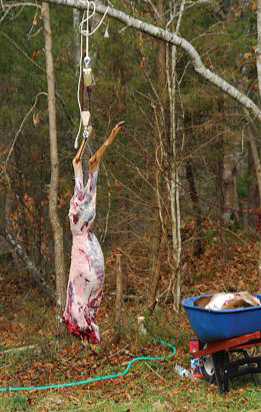
hides and guts in wide open field for
quick cleanup by carrion eaters. If you
have any qualms about that, they can
also simply be buried.
Again, consider the time of year you are dropping the carcass. Radio telemetry research shows that on a typical day, coyotes may move around 4 to 5 miles. This distance does increase during the breeding season and although distances do vary by region across the country, home ranges and other factors should remain close.
In one South Texas study, coyotes form groups of 3 to 7 composed of a mated pair and associates. Home ranges for these coyotes averaged around 10,240-acres for males and 7,680-acres for females. Coyotes will consume carcasses but when small quantities of deer are placed on a site you should not see any large increase in local coyote populations. On my 217 acres, I should only be seeing coyotes hunting within their normal home range and the remains of one carcass are consumed before drawing in transient coyotes.
Raptors
Raptor is the term that takes in all birds of prey, hawks, eagles and even vultures. I can remember my grandfather telling me, “Never shoot a turkey vulture, their job is cleaning up the country.” There’s a lot of truth in this and when you see them circling, they are continually looking for dinner.
According to Bill Lynch, Wildlife Biologist with Kentucky Department of Fish and Wildlife Resources, “Turkey vultures have tremendous ability to smell… several years ago researchers discovered that the turkey vulture is capable of smelling a dead carcass 5,000 feet above the ground.” During an average day a family group of vultures can easily cover 25 to 35 square miles before returning to their roost. One individual vulture Lynch was following with a transmitter covered 60 square miles in one day. Turkey vultures always appear to arrive first, with black vultures keying in on where the turkey vultures are feeding. Black vultures have less ability to see and smell their food than the turkey vulture does. Lynch said, turkey vultures prefer smaller treats, rabbits, coyotes, and he has seen them feeding on snakes and road killed turtles. Turkey vultures were the first to arrive on a fawn that we accidentally killed while cutting hay last summer. I purposely left it onsite, hoping our local eagle would find a meal, but turkey vultures arrived within hours and it was cleaned up that day!
Lynch said, a vulture’s best defense is their immune system, and it would have to be when eating bacteria-laden prey without contracting botulism, anthrax, or cholera…just to name a few.
Years ago, vulture’s sense of smell was used to our benefit. When gas companies started adding scent to gas lines, they realized that turkey vultures would circle leaks in gas lines. It was one of the early methods used to detect leaks.
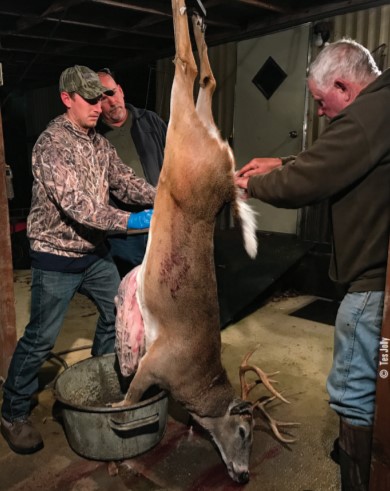
quickly eaten by scavengers if discarded in the right spot.
If you’re not going to make use of the hide, there are
numerous organizations who accept the hide as a
donation.
By far, it appears dropping or leaving the carcass in the woods is the best solution to disposal. Lynch said, “Pick a wide-open field and vultures can generally clean up a deer in a few days, but it depends on how often they are disturbed.” In the winter, many portions of the country will have not only vultures, but there are possibilities for golden eagles and bald eagles.
Chronic Wasting Disease
Earlier in the article I mentioned, “understanding your state’s regulations,” and understanding Chronic Wasting Disease is of utmost importance. CWD has been verified in several locations across the country. This creates problems for what hunters should do with their deer carcasses.
In CWD positive areas, rules are laid out in regulations and if you are hunting in a CWD verified area, it is critically important to have your harvested deer tested and most importantly DO NOT TRANSPORT spinal, head, and bones out of infected areas as these body parts are potential sources of contamination for other locations. Additional recommendations include burying the carcass on site or sealing in a heavy-duty trash bag and depositing in the local landfill. Most importantly follow your state regulations!















